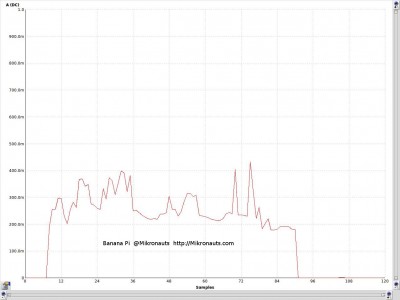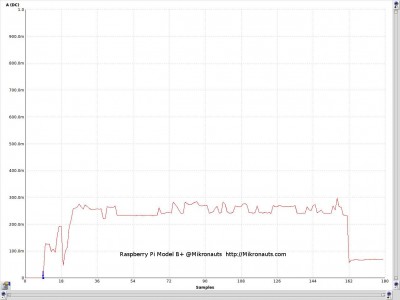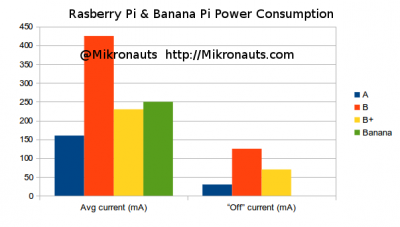Banana Pi Review
Power Utilization
The following chart shows the Banana Pi powering on, automatically going to the desktop, and a web browser being opened (the two spikes on the right), after which it is shut down.
(click on chart for larger image)
The following chart shows the Raspberry Pi Model B+ powering on, automatically going to the desktop, and a web browser being opened (the two spikes on the right), after which it is shut down.
I showed the B+ as it is the current model, and uses far less power than a Model B (see my Raspberry Pi Model B+ review for power comparisons between Model A/B/B+)
(click on chart for larger image)
Here is a chart comparing the average current consumption between the Banana Pi and the Raspberry Pi Models A/B/B+:
(click on chart for larger image)
| Model | A | B | B+ | Banana |
| Avg current (mA) | 160 | 425 | 230 | 250 |
| “Off” current (mA) | 30 | 125 | 70 | 0 |
Banana Pi vs. Raspberry Pi Model A / B / B+ Power Consumption
For average idling current, the Raspberry Pi Model A still has the lowest consumption, with the new Model B+ using a little less juice than the Banana Pi – however note that the BPi has twice the memory, and roughly three times the processing power, so a bit of extra power consumption compared to the new Model B+ is quite understandable. The older Raspberry Pi Model B is left in the proverbial dust.
For “Off” power consumption (after a software shutdown) the Banana Pi is the clear winner – it was not even a contest. It really does fully turn off!
Support
There is absolutely no question that the community support available for the Raspberry Pi dwarfs that available for the Banana Pi.
There is a virtually unstoppable flood of postings on the RPi forums, compared to a trickle on the BPi forums.
Mind you, the Raspberry Pi has been available for a couple of years now, and the Banana Pi has only started selling in July.
Having said that, the Lemaker staff provides great support on their forums – I received prompt and accurate replies to my postings on their forums from the staff, and have not had a single post go unanswered.
Conclusion
The Banana Pi is a great little board, with significantly higher computing power and additional features that make it a better choice than the Raspberry Pi for highly technical users who do not need the community support the Raspberry Pi has, and who need a faster CPU, SATA or faster Ethernet. In the benchmarks run for this review, the Banana Pi won every race excepting raw SD card performance, where the Raspberry Pi had an approximately 20% advantage.
On the other hand, if you are an educational user, who needs the teaching resources that the Raspberry Pi Foundation assists with, and the large user community, the Raspberry Pi is a better choice for you. In these budget limited times even the $15USD difference in price is significant – and let’s face it, the faster CPU, Ethernet and SATA capability don’t really matter in the classroom – at least not in the K-8 range. The Raspberry Pi also has a multi-media edge, so XBMC users are better served with a Raspberry Pi at this time (that may change in time with better driver support for the Allwinner A20).
I expect we will see more Raspberry Pi “clones” as the new super-low-cost single board computer ecosystem evolves.
Welcome to the second computer revolution!
What I liked:
- the dual core Allwinner A20’s far greater compute performance
- 1GB of memory
- SATA port
- Gigabit Ethernet
- on-board RTC
- no current draw when off
What I did not like:
- currently lacking in hardware video decode support
- default of 128MB assigned to video
- RCA video jack is a bit too close to the GPIO header
- Wolfram & Mathematica on the BPi port of Raspbian
- Berryclip clone being called “Berryclip”, troubling as the original Berryclip is not open source hardware
Related Links
- Banana Pi USB WiFi Adapter Tests
- Raspberry Pi Model B+ Review
- Raspberry Pi Model B+ USB WiFi Adapter Tests
- RoboPi product page
- Pi Jumper product page
- EZasPi product page
- Adafruit Proto Plate product page
Review Index
Page 1: Introduction, Does it look the same?
Page 2: Closer Look, Feature Comparison
Page 3: Operating Systems, Software Compatibility
Page 4: WiringPi, RPi.GPIO, Hardware Compatibility
Page 5: More board compatibility test results
Page 6: USB WiFi stick Compatibility, Documentation, Benchmarks
Page 7: Power Utilization, Support, Conclusion


